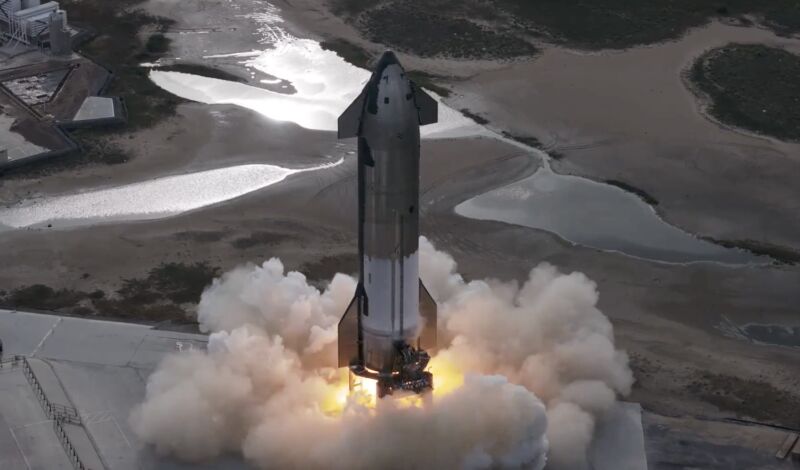“Ship production needs to be roughly an order of magnitude higher than booster production.”
It’s no secret that Elon Musk has big ambitions for SpaceX’s Starship mega-rocket. This is the vehicle that, with plenty of permutations and upgrades, Musk says will ferry cargo and people across the Solar System to build a settlement on Mars, making humanity a multi-planetary species and achieving the billionaire’s long-standing dream.
Of course, that is a long way off. SpaceX is still working on getting Starship into orbit or close to it, an achievement that appears to be possible this year. Then, the company will start launching Starlink satellites on Starship missions while testing in-space refueling technology needed to turn Starship into a human-rated Moon lander for NASA.
SpaceX’s South Texas team is progressing toward the third full-scale Starship test flight. On December 20, the Starship’s upper stage slated for the next test flight completed a test-firing of its Raptor engines at the Starbase launch site on the Texas Gulf Coast. Nine days later, the 33-engine Super Heavy booster fired up on the launch pad for its own static fire test. On the same day, SpaceX hot-fired the Starship upper stage once again on a test stand next to the launch pad.
With those milestones complete, ground teams rolled the booster back to its hangar for final preflight checks and reconfigurations. The ship, too, will need to be rolled back to its high bay.
SpaceX could be weeks away from having both vehicles ready to fly, but the company hasn’t released an update on lessons learned from the previous Starship test flight in November. That flight was largely successful, with apparently flawless performance from the 33 engines on the Super Heavy booster during launch. The Starship upper stage reached space before self-destructing downrange over the Gulf of Mexico. The booster exploded during a maneuver to bring itself back to Earth for a controlled splashdown at sea.
The company’s engineers will want to understand and correct whatever caused those issues. The Federal Aviation Administration then needs to approve SpaceX’s investigation into the last Starship flight before issuing a new commercial launch license. When it flies again, Starship will try to reach near orbital velocity, enough speed to travel most of the way around the world before reentering the atmosphere near Hawaii.
Verifying the performance of Starship’s heat shield tiles during reentry will be valuable learning for SpaceX, but Starship first needs to be fully successful with a launch. This is just the start for the privately funded Starship program.
Aircraft-like operations
Musk has previously said SpaceX might need 1,000 Starships to enable regular flights back and forth between Earth and Mars, and SpaceX would need to build one per week. In a recent post on his social media platform X, Musk suggested SpaceX might need to build Starships at an even faster rate to make a Mars settlement a reality.
“To achieve Mars colonization in roughly three decades, we need ship production to be 100/year, but ideally rising to 300/year,” Musk wrote.
SpaceX still aims to make the Starship and its Super Heavy booster rapidly reusable. The crux is that the ship, the part that would travel into orbit, and eventually to the Moon or Mars, won’t be reused as often as the booster. These ships will come in a number of different configurations, including crew and cargo transports, refueling ships, fuel depots, and satellite deployers.
The booster design will be the same across the different types of ships in the fleet. The Super Heavy, with more than 30 Raptor engines, will also return to SpaceX’s launch sites about six minutes after liftoff, similar to the way SpaceX recovers its Falcon boosters today. Theoretically, Musk wrote, the booster could be ready for another flight in an hour.
With the Starship itself, the laws of physics and the realities of geography come into play. SpaceX will initially have Super Heavy and Starship launch and landing pads in South Texas and Cape Canaveral, Florida, although the company has flirted with the idea of offshore launch and landing platforms.
As an object flies in low-Earth orbit, the Earth rotates underneath it. This means that a satellite, or Starship, will find itself offset some 22.5 degrees in longitude from its launch site after a single 90-minute orbit around the planet. It could take several hours, or up to a day, for a Starship in low-Earth orbit to line up with one of the recovery sites.
“The ship needs to complete at least one orbit, but often several to have the ground track line back up with the launch site, so reuse may only be daily,” Musk wrote. “This means that ship production needs to be roughly an order of magnitude higher than booster production.”
Despite the controversies that follow Musk and his penchant for inflammatory remarks, his statements regarding SpaceX have been level-headed. Musk’s schedule predictions, he has admitted himself, are often aspirational.
Gwynne Shotwell, SpaceX’s second in command, said last year that engineers have “designed Starship to be as much like aircraft operations as we possibly can get it … We want to talk about dozens of launches a day, if not hundreds of launches a day.”
SpaceX needs to launch Starship this often to loft millions of tons of equipment into space for a Mars settlement. And many of these launches will be the Starship refueling tankers needed to make the interplanetary trip possible.
This all may seem rather illusory to discuss before SpaceX has put Starship into orbit. But the company is clearly on a trajectory to do so, then we’ll be talking about when SpaceX might demonstrate in-space refueling, a prerequisite for any Starship journey beyond low-Earth orbit. Then, when will SpaceX successfully recover Super Heavy and Starship and re-fly them? Then, when will Starship land NASA astronauts on the Moon? When will Starship be able to actually launch and land on Earth with people? What about the multi-month trip to Mars?
What’s clear, though, is Musk’s end goal of establishing a settlement on Mars will require rocket travel to be nearly as routine as air travel. Over the last three decades, Boeing has built an average of about 300 of its bestselling 737 aircraft per year. This is the kind of scale Musk is talking about with Starship.
Will this be achievable for Starship within the next three decades? It will definitely require an expansion of SpaceX’s already sizable footprints in South Texas and on Florida’s Space Coast. Musk wants to build Starships close to where they launch.
It’s not a smart bet to doubt human progress, and SpaceX’s hardworking engineers have proven they can solve technical challenges that were thought unattainable. Even for the world’s richest man, it probably will come down to money and a sustained will.

